Most people know about the health-boosting power of green tea but not everyone is aware of its equally powerful skin benefits. To put it simply, a daily cup (or two) of green tea supports a glowing complexion at the same time it promotes heart health, brain function, energy, and so on.
Of course, you don’t even have to drink green tea to use it for skincare. Research has revealed that it has some very promising benefits when applied to your skin as well as when consumed. (Good news for those who aren’t a fan of the flavor.)
To give you an idea of what makes green tea so fantastic, here’s more about one of the most ancient and revered beverages in the world and what it can do for your skin.
The Amazing Properties of Green Tea
Green tea comes from the leaves of the tea plant, Camellia sinensis. Like many other botanicals, it contains a complex mixture of plant compounds and nutrients that all play a role in its numerous health benefits.
However, there is one specific area where green tea really shines: antioxidant content.
You’ve probably heard of antioxidants by now. They are the protective molecules that neutralize free radicals, which are unstable, destructive molecules that contribute to inflammation and chronic diseases like cancer.
Antioxidants are key to longevity and overall health (including skin health), and green tea happens to contain a particularly potent group of antioxidants known as catechins.
By far, the catechin in green tea that has received the most attention is one called epigallocatechin gallate or EGCG for short. It’s something of a “super antioxidant” and has shown impressive properties like fighting inflammation, protecting brain health, and potentially fighting cancer.
As it turns out, EGCG and the other antioxidants in green tea are highly beneficial for your skin, too. You could almost call them an ancient beauty secret.
An Ancient Revered Beverage
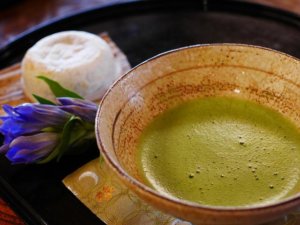
The specific benefits of green tea for skin are considered a modern discovery, but the tea itself has very ancient roots.
Green tea is widely believed to have its origins in China. Legend has it that Emperor Shennong “discovered” it in 2737 BC when he drank water that accidentally had a tea leaf boiled in it. Whether this actually happened or not, green tea remained a cherished beverage for the Chinese elite until about the 14th century.
Despite Chinese origins, green tea is also deeply embedded in Japanese culture and history.
Around the 8th or 9th century, it’s believed that Japanese monks visited China for spiritual purposes and brought green tea back with them. It became a staple in the following centuries, giving energy and calm for meditation and making its way to Japanese emperors.
Green tea still features in Japanese tea ceremonies and eventually become available to common people. It was revered for flavor and as a natural way to promote longevity.
Today, green tea is known to be one of the healthiest beverages you can drink and is a rising ingredient in the skincare world.
Top Benefits of Green Tea for Skin
Anti-Aging Properties
Antioxidants are a key piece of skincare if you want your complexion to look bright and youthful. That’s because free radicals can damage skin cells, degrade collagen and elastin, and generally contribute to old-looking skin— and antioxidants, of course, fight free radical damage.
This means that drinking green tea or applying it to your skin through topical products is a way to protect youthfulness.
In fact, a few small studies have shown that green tea can improve skin elasticity and helps to rejuvenate skin cells. Interestingly, researchers even found that the EGCG in green tea could reactivate dying skin cells, which is pretty incredible!
This ability to reactivate skin cells, according to researchers, could help with a wide range of skin issues, from rosacea and wound healing to wrinkles.
There is one important note here: Because green tea is usually only absorbed into the top layer of skin, you may want to drink it and apply it to get the most antioxidant power.
Calms Inflammation and Puffiness
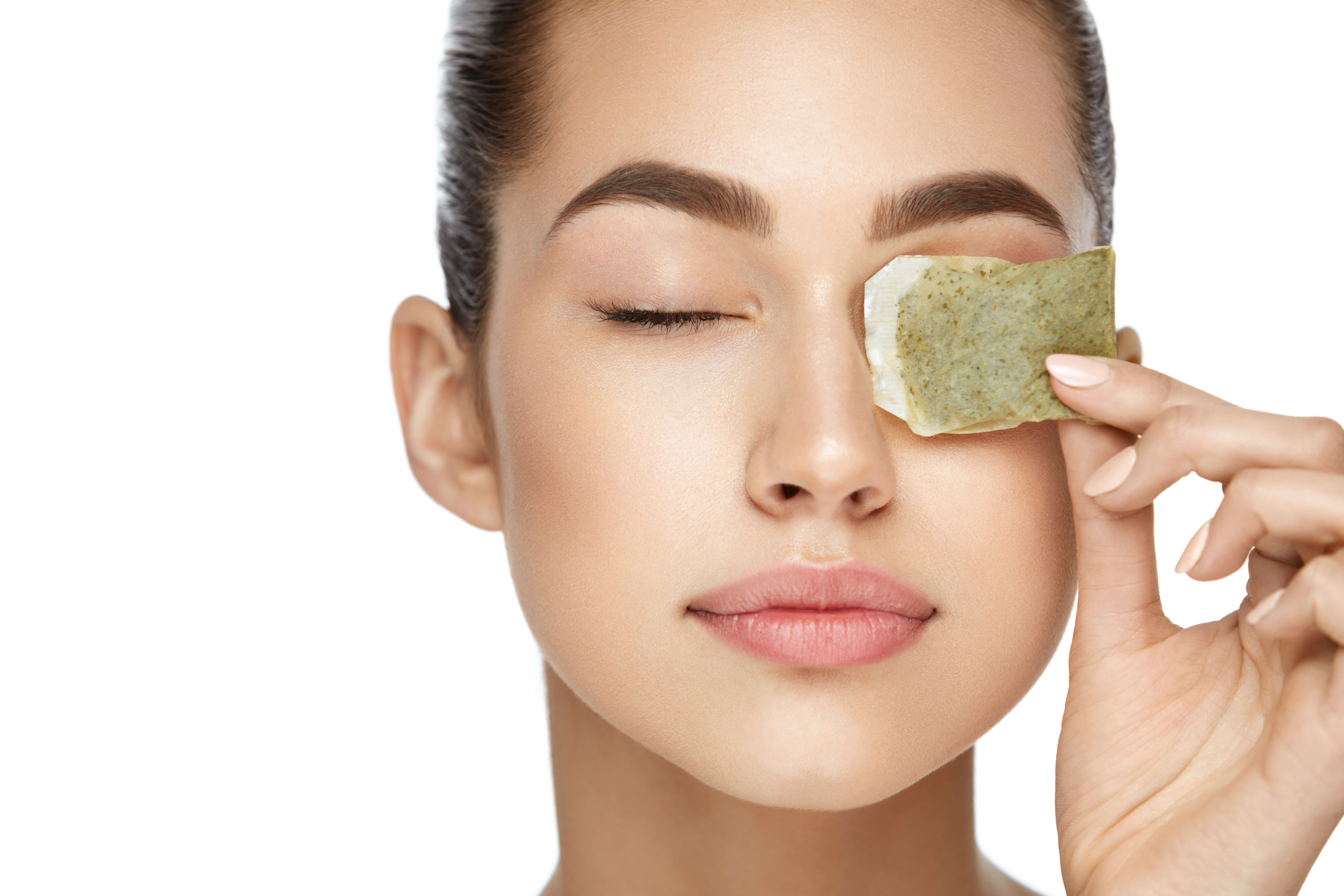
Green tea is well-known for its anti-inflammatory properties. Within your body, this enables it to help ease chronic inflammation and potentially help with inflammatory diseases like diabetes, heart disease, etc.
As you might imagine, the inflammation-calming benefits of green tea apply to your skin as well.
Particularly when used topically, green tea can help to reduce the appearance of redness, swelling, irritation, and other signs of inflammation in your skin. These properties have made it beneficial for managing skin issues like rosacea, dermatitis, and psoriasis.
For the most part, it’s the antioxidant content of green tea that gives it anti-inflammatory power.
However, it also contains small amounts of caffeine and plant compounds known as tannins that have astringent properties. Both of these help to tone skin and reduce puffiness, which makes green tea especially beneficial for the skin around your eyes.
To make a quick remedy for eye puffiness, simply steep green tea bags in hot water, allow them to cool, and place them over your closed eyes for up to 30 minutes.
May Protect Against Photodamage and Skin Cancer
One of the most impressive benefits of green tea for skin is its ability to protect against harmful UV rays.
Sunlight isn’t strictly “bad” for your skin. In fact, your body needs exposure to it in order to produce vitamin D, a very important nutrient. However, sunlight is made up of ultraviolet (UV) rays that can be harmful to your skin when you get overexposed to them.
When your skin gets too much sun over the years, it accumulates into something known as photodamage. This is essentially damaging at the cellular level, and shows up on the surface as wrinkles, fine lines, dark spots, and other signs of aging. At its worst, photodamage results in skin cancer.
Antioxidants are one of the best defenses your skin has against photodamage.
The specific antioxidants within green tea have demonstrated strong photoprotective properties. This means it may be able to help prevent future signs of aging by reducing photodamage. Even more impressively, green tea has been found to enhance DNA repair and may help prevent melanoma and non-melanoma skin cancers.
Helpful for Breakout-Prone Skin
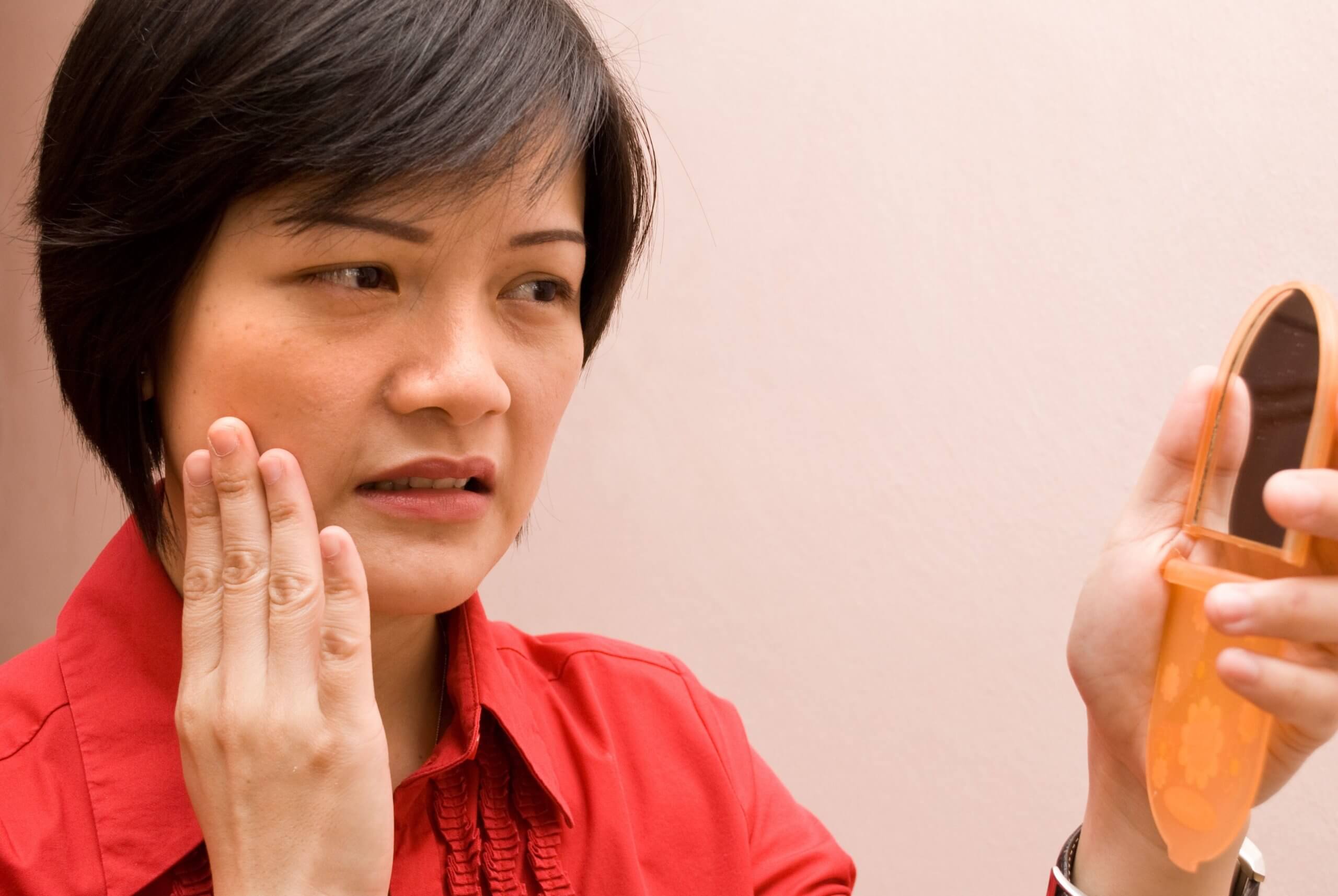
Applying green tea to your skin in the form of an extract or tea-based product can be very helpful if you struggle with breakouts. Green tea isn’t strong enough to fight severe acne, but it does have several benefits for milder forms.
To start with, the antioxidants in green tea (particularly EGCG) have both anti-inflammatory and antimicrobial properties. This helps to calm the inflammation associated with breakouts and may fight the bacteria that contributes to acne.
EGCG has actually been shown to inhibit a wide range of microbes, including some that affect the skin. But unlike harsher topical treatments, there’s no evidence that it kills beneficial bacteria, which is important for keeping your skin’s microbiome healthy.
There are also benefits of green tea for skin that gets oily— something that usually goes hand-in-hand with acne.
A few studies have demonstrated that topical green tea products can reduce sebum secretion. This not only helps to reduce oiliness, it also helps to keep your pores unclogged, which should result in fewer breakouts.
Hydrates and Balances Skin
In spite of the fact that green tea fights oily skin, it also has hydrating properties that help your skin to retain moisture. You can think of it as a balancing botanical that works for every skin type.
According to one study in which participants applied a green tea formulation to their skin, it had “pronounced moisturizing effects” and also improved skin roughness. Notably, these changes happened over a 15-30 day period, so you’ll need to give it a little time to go to work.
One possible reason behind green tea’s hydrating effect is the fact that it contains vitamin E.
Vitamin E is a very powerful skin nutrient. It has benefits both when you consume it in your diet and when you apply it topically to your skin.
As an antioxidant, vitamin E helps to protect your skin from photodamage. It works best when used alongside vitamin C (which is also in green tea) and helps to calm inflammation as well. Vitamin E also helps to attract and trap water in your skin, making it a great hydrator.
May Boost Collagen Levels
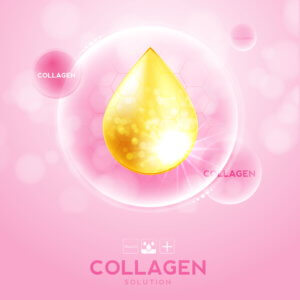
As you may know, collagen is an incredibly important skin protein. It makes up over 70% of your skin’s structure and gives it strength and flexibility. By keeping skin firm and plump, collagen is a top anti-aging protein that helps to fend off wrinkles, fine lines, and “deflated-looking” skin.
Unfortunately, collagen starts degrading or declining in your body as you get older. This majorly contributes to old-looking skin and is something that needs to be addressed if you want a more youthful complexion.
The good news is that there are very promising benefits of green tea as a collagen-booster for skin. It contains both vitamin C and vitamin E, which work in sync to promote collagen synthesis, as well as vitamin B2, which is thought to help maintain collagen in the skin.
Some research has also shown that green tea can help delay collagen aging, protecting existing collagen in your skin from degrading.
How to Use Green Tea for Your Skin + Recipes
There are multiple ways to get the benefits of green tea for skin. As mentioned earlier, one of the best approaches is to both consume and apply green tea for maximum effect.
If you enjoy the flavor of green tea, there are multiple varieties of it to add to your daily routine. Matcha, which is made of powdered green tea leaves, has the highest EGCG and antioxidant content by far simply because it’s so concentrated. But you can still get lots of benefits from teas like sencha, genmaicha, and gunpowder green.
When it comes to nutrient content, there are different ways to approach green tea.
For the maximum amount of EGCG, the tea leaves should be steeped, since hot water seems to help extract this specific antioxidant. However, for maximum vitamin C content, use raw matcha powder, since this vitamin is very sensitive to heat.
Not sure where to start? Here are some green tea recipes to help your skin from inside and out.
Simple Matcha Tea Recipe
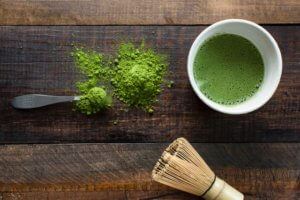
Ingredients:
- 1-2 teaspoons organic matcha powder
- 2 ounces hot water, plus 3-4 additional ounces hot water
- Sweetener (optional)
Instructions:
- Sift the matcha powder into a mug or bowl.
- Heat your water just short of boiling and pour 2 ounces of it over the matcha.
- Whisk the mixture thoroughly, using a bamboo whisk if you want to go the traditional route.
- Add the rest of the water slowly, whisking as you go, until you get the flavor and consistency you want.
- Stir in a natural sweetener, like honey or maple syrup, if desired.
To turn this recipe into a matcha latte, simply whisk 1 tablespoon of hot water into the powder, then add about 3/4 cups of hot milk (dairy or plant-based).
Matcha Smoothie
If you want to get the benefits of raw green tea for your skin, a matcha smoothie is the way to go. Here’s a version with greens for extra antioxidants and banana for sweetness.
Ingredients:
- 1 cup frozen banana slices
- 1 cup fresh greens (spinach, kale, etc.)
- 1-2 teaspoons organic matcha powder
- 1/2 teaspoon vanilla extract
- 3/4-1 cup milk (dairy, almond, oat, etc.)
- Sweetener to taste
Instructions:
- Add all of the ingredients to your blender and blend until smooth. Use more or less milk to get your preferred consistency.
To make this smoothie even more refreshing, try adding some lemon juice or tropical fruits like mango and pineapple.
Green Tea Face Mask
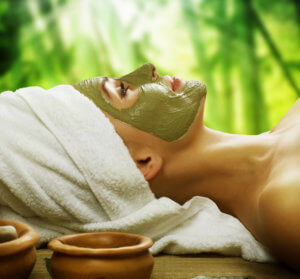
Option #1:
- Mix 1-2 teaspoons of matcha powder with 1/2 teaspoon raw honey and enough water to make a paste-like consistency.
- Apply the mixture to your face and allow it to sit for 15-20 minutes before rinsing off.
Option #2:
- Brew a strong cup of green tea and allow it to cool.
- Mix enough of the green tea into 3-4 tablespoons of a base like rice flour, ground oats, or bentonite clay to make a paste-like consistency.
- Apply the mask to your face and allow it to sit for 15-20 minutes before rinsing off.
Next Up: The Extract More Powerful than Green Tea
The multiple benefits of green tea for skin make it one of the best skincare ingredients and one of the best skin-boosting beverages.
But surprisingly, green tea isn’t the most powerful natural skincare ingredient out there.
If you’re interested in an even more potent anti-aging plant extract, read about bakuchiol and what it can do for your skin here. This superstar botanical is so promising that it has been labeled a potential “natural retinol alternative” and can combat multiple signs of aging like wrinkles, dark spots, and saggy skin.
Learn more about bakuchiol here— while you’re sipping some green tea, of course!


